Abstract
Polychlorinated biphenyls (PCBs) are industrial compounds that have been detected as contaminants in almost every component of the global ecosystem including the air, water, sediments, fish, and wildlife and human adipose tissue, milk, and serum. PCBs in commercial products and environmental extracts are complex mixtures of isomers and congeners that can now be analyzed on a congener-specific basis using high-resolution gas chromatographic analysis. PCBs are metabolized primarily via mixed-function oxidases into a broad spectrum of metabolites. The results indicate that metabolic activation is not required for PCB toxicity, and the parent hydrocarbons are responsible for most of the biochemical and toxic responses elicited by these compounds. Some of these responses include developmental and reproductive toxicity, dermal toxicity, endocrine effects, hepatotoxicity, carcinogenesis, and the induction of diverse phase I and phase II drug-metabolizing enzymes. Many of the effects observed for the commercial PCBs are similar to those reported for 2,3,7,8-tetrachlorodibenzo-p-dioxin (TCDD) and related compounds. Structure-function relationships for PCB congeners have identified two major structural classes of PCBs that elicit "TCDD-like" responses, namely, the coplanar PCBs (e.g., 3,3',4,4'-tetraCB, 3,3'4,4',5-pentaCB and 3,3',4,4',5,5'-hexaCB) and their mono-ortho coplanar derivatives. These compounds competitively bind to the TCDD or aryl hydrocarbon (Ah) receptor and exhibit Ah receptor agonist activity. In addition, other structural classes of PCBs elicit biochemical and toxic responses that are not mediated through the Ah receptor. The shor-term effects of PCBs on occupationally exposed humans appear to be reversible, and no consistent changes in overall mortality and cancer mortality have been reported. Recent studies have demonstrated that some developmental deficits in infants and children correlated with in utero exposure to PCBs; however, the etiologic agent(s) or structural class of PCBs responsible for these effects have not been delineated. In contrast, based on a toxic equivalency factor approach, the reproductive and developmental problems in certain wildlife populations appear to be related to the TCDD-like PCB congeners.
Full text
PDF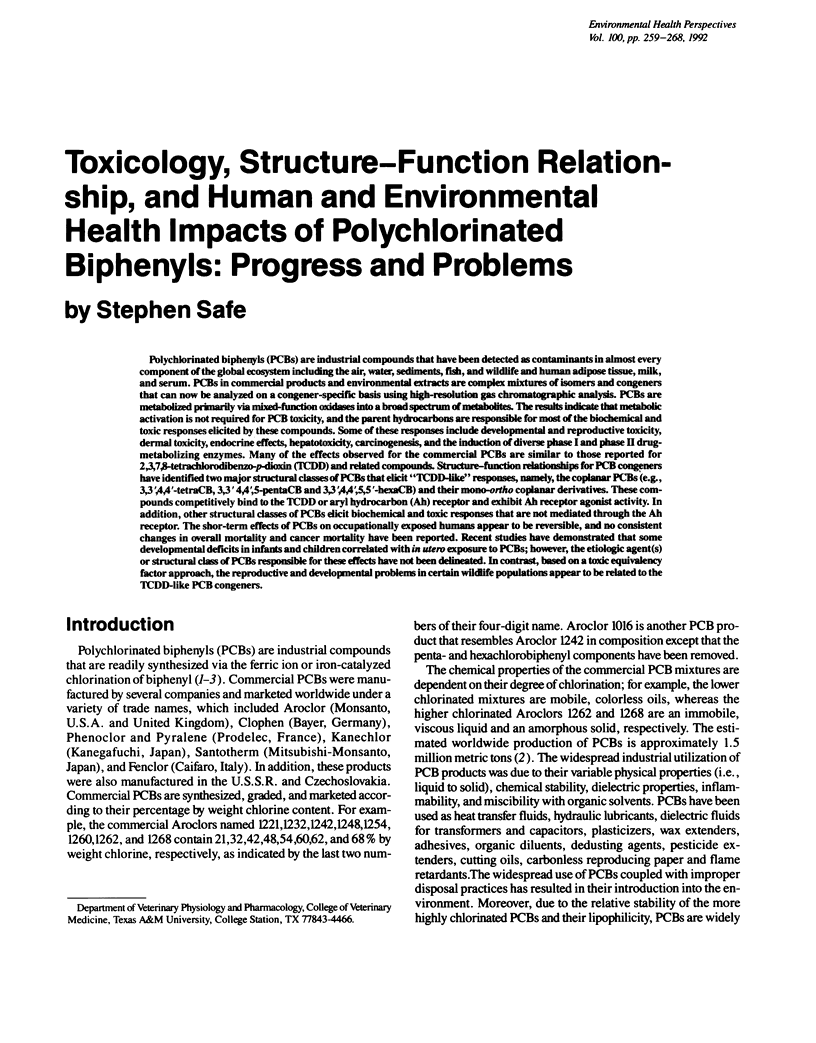
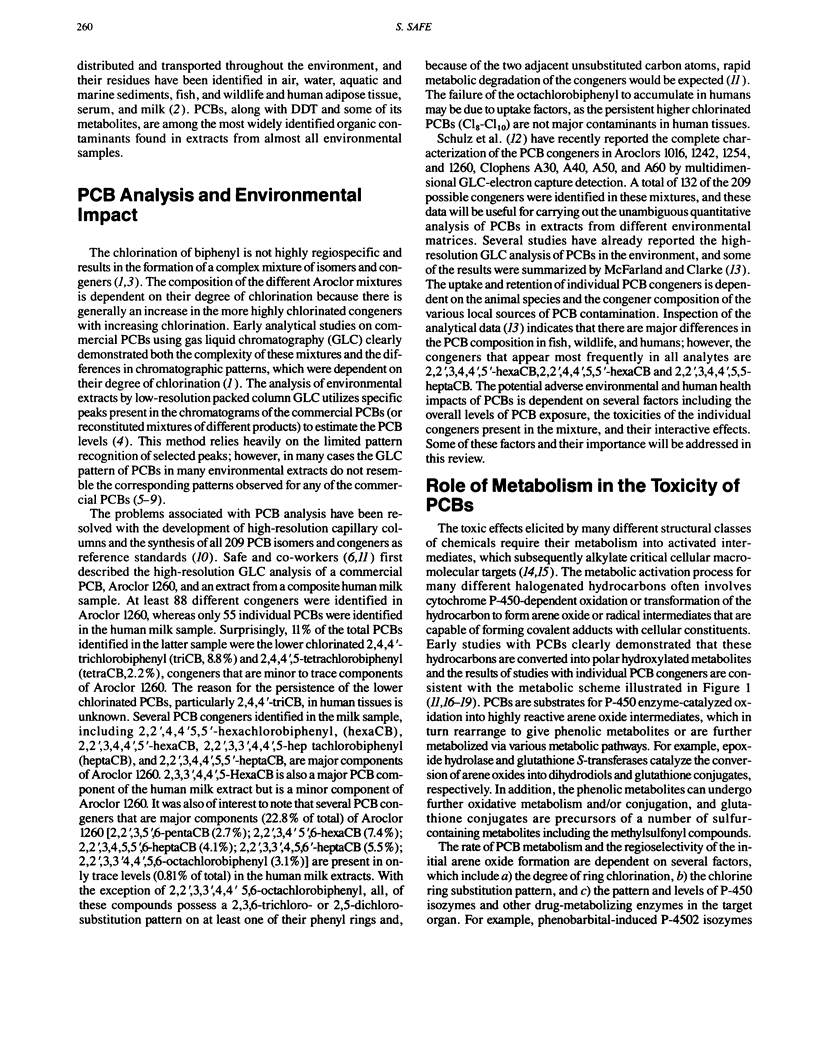
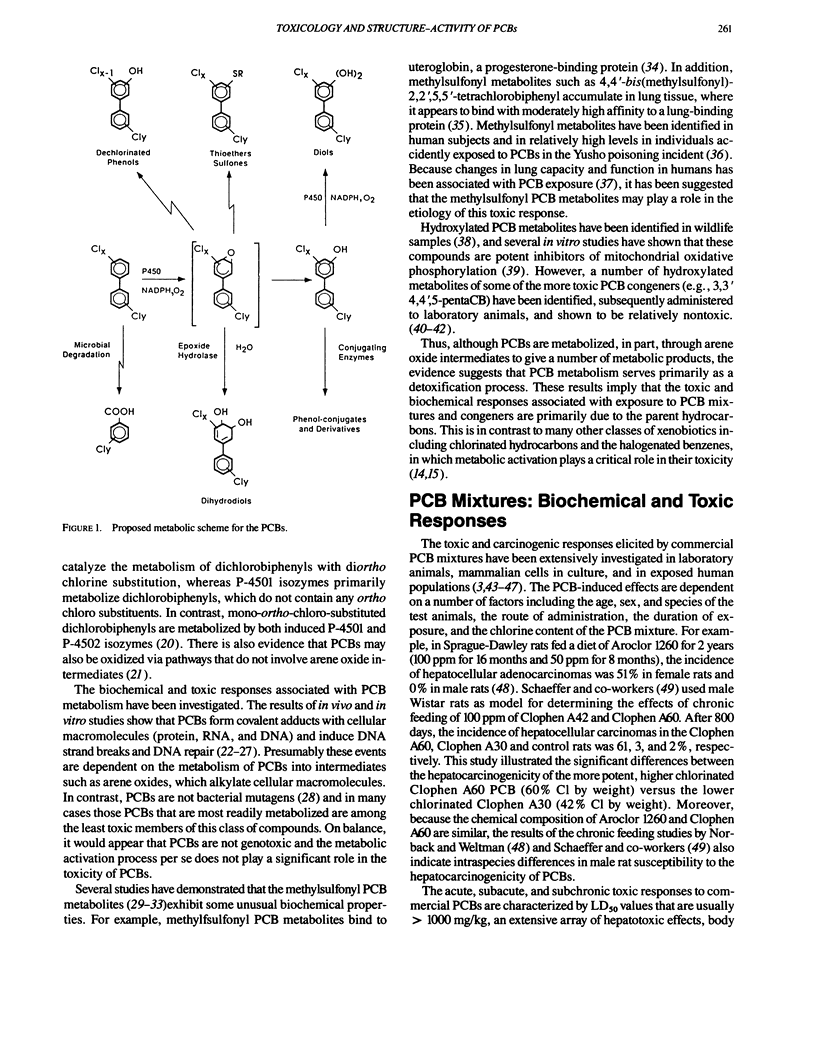


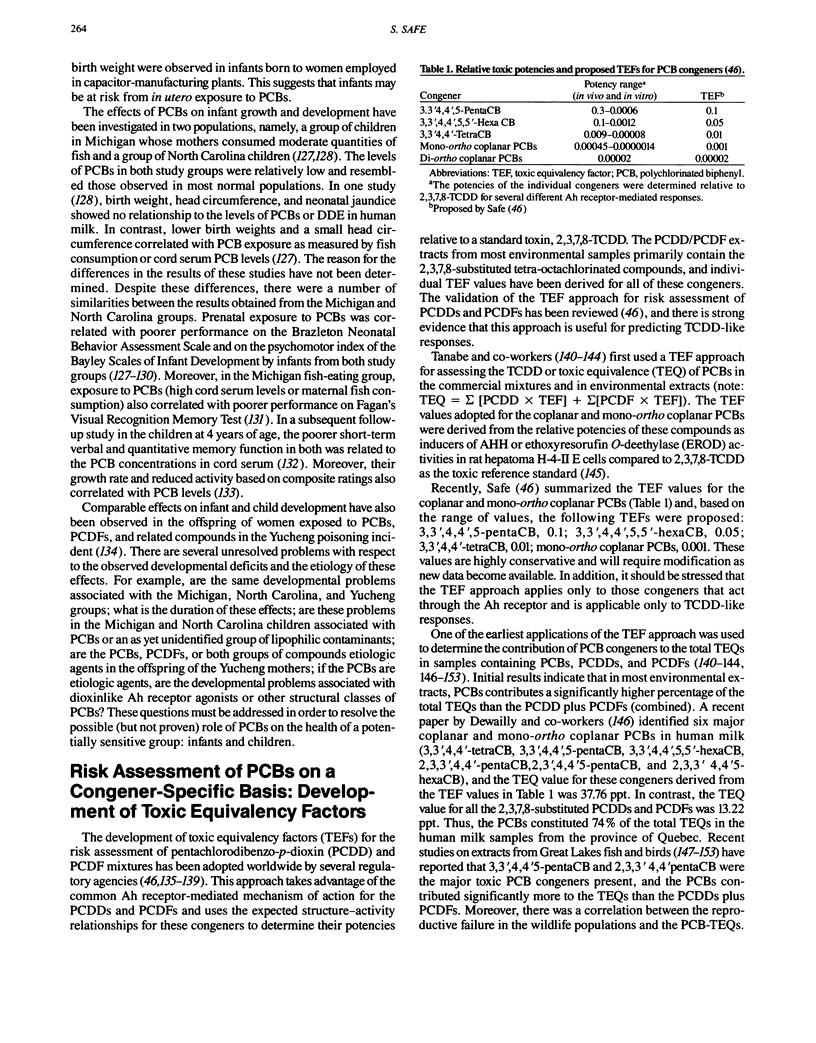
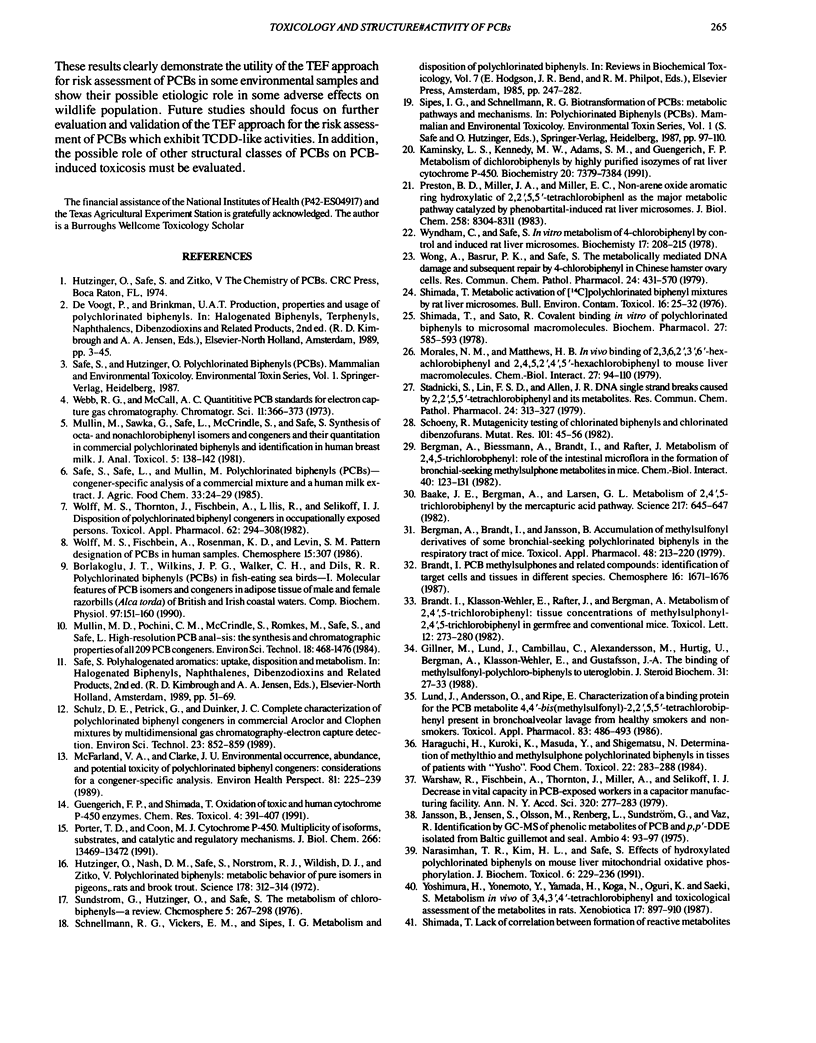
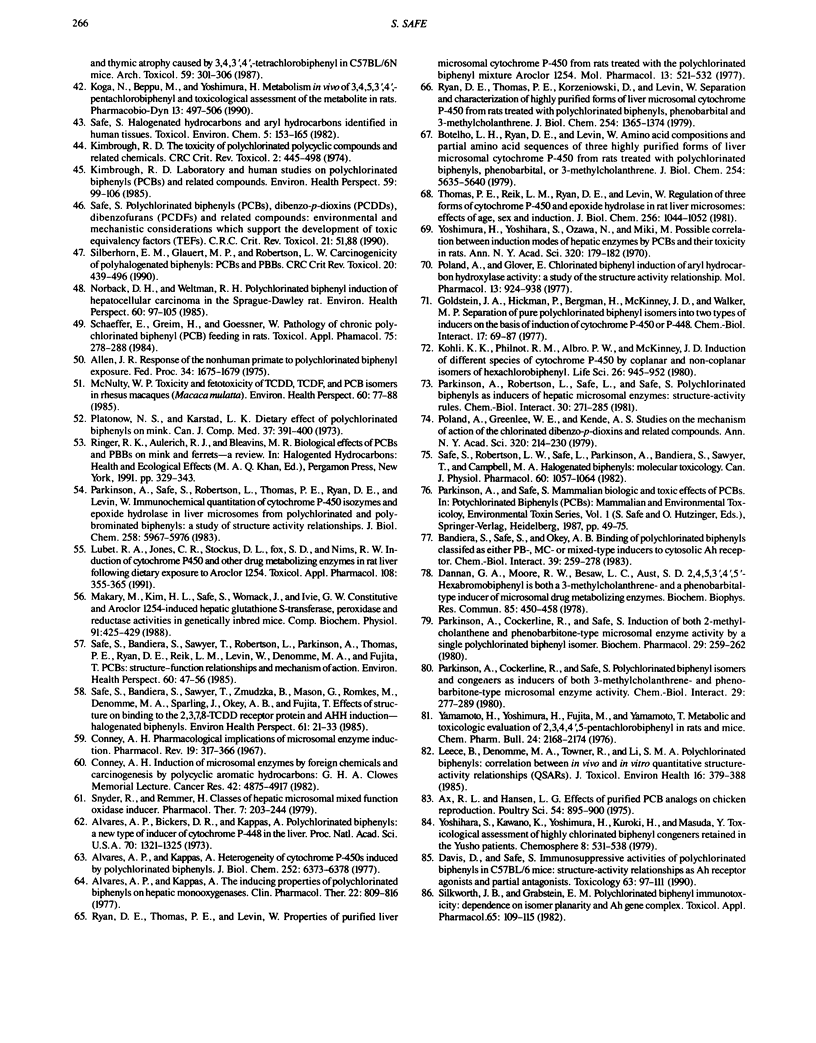

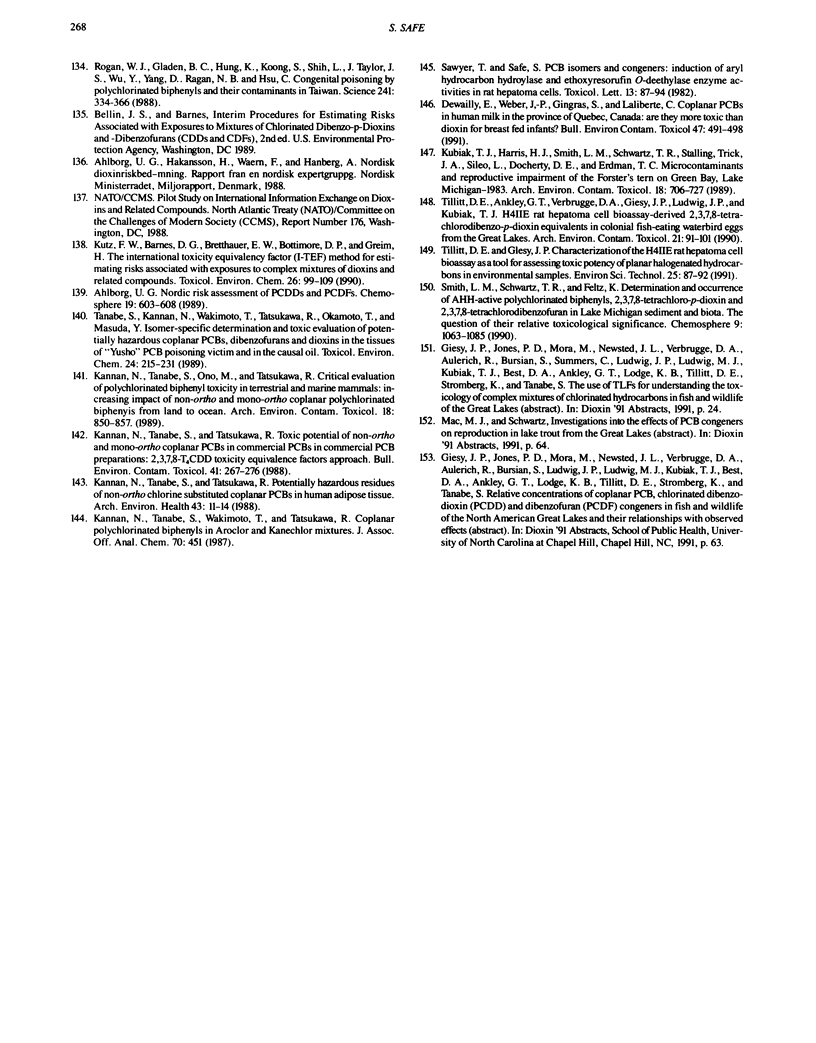
Selected References
These references are in PubMed. This may not be the complete list of references from this article.
- Allen J. R. Response of the nonhuman primate to polychlorinated biphenyl exposure. Fed Proc. 1975 Jul;34(8):1675–1679. [PubMed] [Google Scholar]
- Alvares A. P., Bickers D. R., Kappas A. Polychlorinated biphenyls: a new type of inducer of cytochrome P-448 in the liver. Proc Natl Acad Sci U S A. 1973 May;70(5):1321–1325. doi: 10.1073/pnas.70.5.1321. [DOI] [PMC free article] [PubMed] [Google Scholar]
- Alvares A. P., Fischbein A., Anderson K. E., Kappas A. Alterations in drug metabolism in workers exposed to polychlorinated biphenyls. Clin Pharmacol Ther. 1977 Aug;22(2):140–146. doi: 10.1002/cpt1977222140. [DOI] [PubMed] [Google Scholar]
- Alvares A. P., Kappas A. Heterogeneity of cytochrome P-450s induced by polychlorinated biphenyls. J Biol Chem. 1977 Sep 25;252(18):6373–6378. [PubMed] [Google Scholar]
- Alvares A. P., Kappas A. The inducing properties of polychlorinated biphenyls on hepatic monooxygenases. Clin Pharmacol Ther. 1977 Nov;22(5 Pt 2):809–816. doi: 10.1002/cpt1977225part2809. [DOI] [PubMed] [Google Scholar]
- Ax R. L., Hansen L. G. Effects of purified polychlorinated biphenyl analogs on chicken reproduction. Poult Sci. 1975 May;54(3):895–900. doi: 10.3382/ps.0540895. [DOI] [PubMed] [Google Scholar]
- Bakke J. E., Bergman A. L., Larsen G. L. Metabolism of 2,4',5-trichlorobiphenyl by the mercapturic acid pathway. Science. 1982 Aug 13;217(4560):645–647. doi: 10.1126/science.6806905. [DOI] [PubMed] [Google Scholar]
- Bandiera S., Safe S., Okey A. B. Binding of polychlorinated biphenyls classified as either phenobarbitone-, 3-methylcholanthrene- or mixed-type inducers to cytosolic Ah receptor. Chem Biol Interact. 1982 Apr;39(3):259–277. doi: 10.1016/0009-2797(82)90045-x. [DOI] [PubMed] [Google Scholar]
- Bergman A., Biessmann A., Brandt I., Rafter J. Metabolism of 2,4',5-trichlorobiphenyl: role of the intestinal microflora in the formation of bronchial-seeking methyl sulphone metabolites in mice. Chem Biol Interact. 1982 Jun;40(2):123–131. doi: 10.1016/0009-2797(82)90094-1. [DOI] [PubMed] [Google Scholar]
- Bergman A., Brandt I., Jansson B. Accumulation of methylsulfonyl derivatives of some bronchial-seeking polychlorinated biphenyls in the respiratory tract of mice. Toxicol Appl Pharmacol. 1979 Apr;48(2):213–220. doi: 10.1016/0041-008x(79)90026-7. [DOI] [PubMed] [Google Scholar]
- Bertazzi P. A., Riboldi L., Pesatori A., Radice L., Zocchetti C. Cancer mortality of capacitor manufacturing workers. Am J Ind Med. 1987;11(2):165–176. doi: 10.1002/ajim.4700110206. [DOI] [PubMed] [Google Scholar]
- Botelho L. H., Ryan D. E., Levin W. Amino acid compositions and partial amino acid sequences of three highly purified forms of liver microsomal cytochrome P-450 from rats treated with polychlorinated biphenyls, phenobarbital, or 3-methylcholanthrene. J Biol Chem. 1979 Jul 10;254(13):5635–5640. [PubMed] [Google Scholar]
- Bowes C. W., Mulvihill M. J., Simoneit B. R., Burlingame A. L., Risebrough R. W. Identification of chlorinated dibenzofurans in American polychlorinated biphenyls. Nature. 1975 Jul 24;256(5515):305–307. doi: 10.1038/256305b0. [DOI] [PubMed] [Google Scholar]
- Brandt I., Klasson-Wehler E., Rafter J., Bergman A. Metabolism of 2,4',5-trichlorobiphenyl: tissue concentrations of methylsulphonyl-2,4',5-trichlorobiphenyl in germfree and conventional mice. Toxicol Lett. 1982 Aug;12(4):273–280. doi: 10.1016/0378-4274(82)90251-x. [DOI] [PubMed] [Google Scholar]
- Brown D. P., Jones M. Mortality and industrial hygiene study of workers exposed to polychlorinated biphenyls. Arch Environ Health. 1981 May-Jun;36(3):120–129. doi: 10.1080/00039896.1981.10667615. [DOI] [PubMed] [Google Scholar]
- Brown D. P. Mortality of workers exposed to polychlorinated biphenyls--an update. Arch Environ Health. 1987 Nov-Dec;42(6):333–339. doi: 10.1080/00039896.1987.9934355. [DOI] [PubMed] [Google Scholar]
- Buchmann A., Kunz W., Wolf C. R., Oesch F., Robertson L. W. Polychlorinated biphenyls, classified as either phenobarbital- or 3-methylcholanthrene-type inducers of cytochrome P-450, are both hepatic tumor promoters in diethylnitrosamine-initiated rats. Cancer Lett. 1986 Sep;32(3):243–253. doi: 10.1016/0304-3835(86)90176-x. [DOI] [PubMed] [Google Scholar]
- Chase K. H., Wong O., Thomas D., Berney B. W., Simon R. K. Clinical and metabolic abnormalities associated with occupational exposure to polychlorinated biphenyls (PCBs). J Occup Med. 1982 Feb;24(2):109–114. [PubMed] [Google Scholar]
- Conney A. H. Induction of microsomal enzymes by foreign chemicals and carcinogenesis by polycyclic aromatic hydrocarbons: G. H. A. Clowes Memorial Lecture. Cancer Res. 1982 Dec;42(12):4875–4917. [PubMed] [Google Scholar]
- Conney A. H. Pharmacological implications of microsomal enzyme induction. Pharmacol Rev. 1967 Sep;19(3):317–366. [PubMed] [Google Scholar]
- Dannan G. A., Moore R. W., Besaw L. C., Aust S. D. 2,4,5,3',4',5'-Hexabromobiphenyl is both a 3-methylcholanthrene-and a phenobarbital-type inducer of microsomal drug metabolizing enzymes. Biochem Biophys Res Commun. 1978 Nov 14;85(1):450–458. doi: 10.1016/s0006-291x(78)80063-1. [DOI] [PubMed] [Google Scholar]
- Davis D., Safe S. Immunosuppressive activities of polychlorinated biphenyls in C57BL/6N mice: structure-activity relationships as Ah receptor agonists and partial antagonists. Toxicology. 1990 Jul;63(1):97–111. doi: 10.1016/0300-483x(90)90072-o. [DOI] [PubMed] [Google Scholar]
- Denomme M. A., Bandiera S., Lambert I., Copp L., Safe L., Safe S. Polychlorinated biphenyls as phenobarbitone-type inducers of microsomal enzymes. Structure-activity relationships for a series of 2,4-dichloro-substituted congeners. Biochem Pharmacol. 1983 Oct 1;32(19):2955–2963. doi: 10.1016/0006-2952(83)90402-1. [DOI] [PubMed] [Google Scholar]
- Dewailly E., Weber J. P., Gingras S., Laliberté C. Coplanar PCBs in human milk in the province of Québec, Canada: are they more toxic than dioxin for breast fed infants? Bull Environ Contam Toxicol. 1991 Oct;47(4):491–498. doi: 10.1007/BF01700935. [DOI] [PubMed] [Google Scholar]
- Emmett E. A. Polychlorinated biphenyl exposure and effects in transformer repair workers. Environ Health Perspect. 1985 May;60:185–192. doi: 10.1289/ehp.8560185. [DOI] [PMC free article] [PubMed] [Google Scholar]
- Eriksson P. Effects of 3,3',4,4'-tetrachlorobiphenyl in the brain of the neonatal mouse. Toxicology. 1988 Apr;49(1):43–48. doi: 10.1016/0300-483x(88)90172-2. [DOI] [PubMed] [Google Scholar]
- Fein G. G., Jacobson J. L., Jacobson S. W., Schwartz P. M., Dowler J. K. Prenatal exposure to polychlorinated biphenyls: effects on birth size and gestational age. J Pediatr. 1984 Aug;105(2):315–320. doi: 10.1016/s0022-3476(84)80139-0. [DOI] [PubMed] [Google Scholar]
- Gillner M., Lund J., Cambillau C., Alexandersson M., Hurtig U., Bergman A., Klasson-Wehler E., Gustafsson J. A. The binding of methylsulfonyl-polychloro-biphenyls to uteroglobin. J Steroid Biochem. 1988 Jul;31(1):27–33. doi: 10.1016/0022-4731(88)90201-4. [DOI] [PubMed] [Google Scholar]
- Gladen B. C., Rogan W. J., Hardy P., Thullen J., Tingelstad J., Tully M. Development after exposure to polychlorinated biphenyls and dichlorodiphenyl dichloroethene transplacentally and through human milk. J Pediatr. 1988 Dec;113(6):991–995. doi: 10.1016/s0022-3476(88)80569-9. [DOI] [PubMed] [Google Scholar]
- Goldstein J. A., Hickman P., Bergman H., McKinney J. D., Walker M. P. Separation of pure polychlorinated biphenyl isomers into two types of inducers on the basis of induction of cytochrome P-450 or P-448. Chem Biol Interact. 1977 Apr;17(1):69–87. doi: 10.1016/0009-2797(77)90073-4. [DOI] [PubMed] [Google Scholar]
- Guengerich F. P., Shimada T. Oxidation of toxic and carcinogenic chemicals by human cytochrome P-450 enzymes. Chem Res Toxicol. 1991 Jul-Aug;4(4):391–407. doi: 10.1021/tx00022a001. [DOI] [PubMed] [Google Scholar]
- Gustavsson P., Hogstedt C., Rappe C. Short-term mortality and cancer incidence in capacitor manufacturing workers exposed to polychlorinated biphenyls (PCBs). Am J Ind Med. 1986;10(4):341–344. doi: 10.1002/ajim.4700100402. [DOI] [PubMed] [Google Scholar]
- Haraguchi H., Kuroki H., Masuda Y., Shigematsu N. Determination of methylthio and methylsulphone polychlorinated biphenyls in tissues of patients with 'yusho'. Food Chem Toxicol. 1984 Apr;22(4):283–288. doi: 10.1016/0278-6915(84)90007-3. [DOI] [PubMed] [Google Scholar]
- Hutzinger O., Nash D. M., Safe S., DeFreitas A. S., Norstrom R. J., Wildish D. J., Zitko V. Polychlorinated biphenyls: metabolic behavior of pure isomers in pigeons, rats, and brook trout. Science. 1972 Oct 20;178(4058):312–314. doi: 10.1126/science.178.4058.312. [DOI] [PubMed] [Google Scholar]
- Jacobson J. L., Jacobson S. W., Humphrey H. E. Effects of exposure to PCBs and related compounds on growth and activity in children. Neurotoxicol Teratol. 1990 Jul-Aug;12(4):319–326. doi: 10.1016/0892-0362(90)90050-m. [DOI] [PubMed] [Google Scholar]
- Jacobson J. L., Jacobson S. W., Humphrey H. E. Effects of in utero exposure to polychlorinated biphenyls and related contaminants on cognitive functioning in young children. J Pediatr. 1990 Jan;116(1):38–45. doi: 10.1016/s0022-3476(05)81642-7. [DOI] [PubMed] [Google Scholar]
- Jacobson S. W., Fein G. G., Jacobson J. L., Schwartz P. M., Dowler J. K. The effect of intrauterine PCB exposure on visual recognition memory. Child Dev. 1985 Aug;56(4):853–860. [PubMed] [Google Scholar]
- Kaminsky L. S., Kennedy M. W., Adams S. M., Guengerich F. P. Metabolism of dichlorobiphenyls by highly purified isozymes of rat liver cytochrome P-450. Biochemistry. 1981 Dec 22;20(26):7379–7384. doi: 10.1021/bi00529a009. [DOI] [PubMed] [Google Scholar]
- Kannan N., Tanabe S., Ono M., Tatsukawa R. Critical evaluation of polychlorinated biphenyl toxicity in terrestrial and marine mammals: increasing impact of non-ortho and mono-ortho coplanar polychlorinated biphenyls from land to ocean. Arch Environ Contam Toxicol. 1989 Nov;18(6):850–857. doi: 10.1007/BF01160300. [DOI] [PubMed] [Google Scholar]
- Kannan N., Tanabe S., Tatsukawa R. Potentially hazardous residues of non-ortho chlorine substituted coplanar PCBs in human adipose tissue. Arch Environ Health. 1988 Jan-Feb;43(1):11–14. doi: 10.1080/00039896.1988.9934366. [DOI] [PubMed] [Google Scholar]
- Kannan N., Tanabe S., Tatsukawa R. Toxic potential of non-ortho and mono-ortho coplanar PCBs in commercial PCB preparations: "2,3,7,8-T4 CDD toxicity equivalence factors approach. Bull Environ Contam Toxicol. 1988 Aug;41(2):267–276. doi: 10.1007/BF01705441. [DOI] [PubMed] [Google Scholar]
- Kannan N., Tanabe S., Wakimoto T., Tatsukawa R. Coplanar polychlorinated biphenyls in aroclor and kanechlor mixtures. J Assoc Off Anal Chem. 1987 May-Jun;70(3):451–454. [PubMed] [Google Scholar]
- Kimbrough R. D. Human health effects of polychlorinated biphenyls (PCBs) and polybrominated biphenyls (PBBs). Annu Rev Pharmacol Toxicol. 1987;27:87–111. doi: 10.1146/annurev.pa.27.040187.000511. [DOI] [PubMed] [Google Scholar]
- Kimbrough R. D. Laboratory and human studies on polychlorinated biphenyls (PCBs) and related compounds. Environ Health Perspect. 1985 Feb;59:99–106. doi: 10.1289/ehp.59-1568093. [DOI] [PMC free article] [PubMed] [Google Scholar]
- Kimbrough R. D. The toxicity of polychlorinated polycyclic compounds and related chemicals. CRC Crit Rev Toxicol. 1974 Jan;2(4):445–498. doi: 10.3109/10408447309025705. [DOI] [PubMed] [Google Scholar]
- Koga N., Beppu M., Yoshimura H. Metabolism in vivo of 3,4,5,3',4'-pentachlorobiphenyl and toxicological assessment of the metabolite in rats. J Pharmacobiodyn. 1990 Aug;13(8):497–506. doi: 10.1248/bpb1978.13.497. [DOI] [PubMed] [Google Scholar]
- Kohli K. K., Philpot R. M., Albro P. W., McKinney J. D. Induction of different species of cytochrome P-450 by coplanar and noncoplanar isomers of hexachlorobiphenyl. Life Sci. 1980 Mar 24;26(12):945–952. doi: 10.1016/0024-3205(80)90115-0. [DOI] [PubMed] [Google Scholar]
- Kreiss K. Studies on populations exposed to polychlorinated biphenyls. Environ Health Perspect. 1985 May;60:193–199. doi: 10.1289/ehp.8560193. [DOI] [PMC free article] [PubMed] [Google Scholar]
- Kubiak T. J., Harris H. J., Smith L. M., Schwartz T. R., Stalling D. L., Trick J. A., Sileo L., Docherty D. E., Erdman T. C. Microcontaminants and reproductive impairment of the Forster's tern on Green Bay, Lake Michigan--1983. Arch Environ Contam Toxicol. 1989 Sep;18(5):706–727. doi: 10.1007/BF01225009. [DOI] [PubMed] [Google Scholar]
- Lawton R. W., Ross M. R., Feingold J., Brown J. F., Jr Effects of PCB exposure on biochemical and hematological findings in capacitor workers. Environ Health Perspect. 1985 May;60:165–184. doi: 10.1289/ehp.8560165. [DOI] [PMC free article] [PubMed] [Google Scholar]
- Leece B., Denomme M. A., Towner R., Li S. M., Safe S. Polychlorinated biphenyls: correlation between in vivo and in vitro quantitative structure-activity relationships (QSARs). J Toxicol Environ Health. 1985;16(3-4):379–388. doi: 10.1080/15287398509530748. [DOI] [PubMed] [Google Scholar]
- Lilienthal H., Neuf M., Munoz C., Winneke G. Behavioral effects of pre- and postnatal exposure to a mixture of low chlorinated PCBs in rats. Fundam Appl Toxicol. 1990 Oct;15(3):457–467. doi: 10.1016/0272-0590(90)90032-f. [DOI] [PubMed] [Google Scholar]
- Lilienthal H., Winneke G. Sensitive periods for behavioral toxicity of polychlorinated biphenyls: determination by cross-fostering in rats. Fundam Appl Toxicol. 1991 Aug;17(2):368–375. doi: 10.1016/0272-0590(91)90226-t. [DOI] [PubMed] [Google Scholar]
- Lubet R. A., Jones C. R., Stockus D. L., Fox S. D., Nims R. W. Induction of cytochrome P450 and other drug metabolizing enzymes in rat liver following dietary exposure to Aroclor 1254. Toxicol Appl Pharmacol. 1991 Apr;108(2):355–365. doi: 10.1016/0041-008x(91)90124-w. [DOI] [PubMed] [Google Scholar]
- Lund J., Anderson O., Ripe E. Characterization of a binding protein for the PCB metabolite 4,4'-bis(methylsulfonyl)-2,2',5,5'-tetrachlorobiphenyl present in bronchoalveolar lavage from healthy smokers and non-smokers. Toxicol Appl Pharmacol. 1986 May;83(3):486–493. doi: 10.1016/0041-008x(86)90231-0. [DOI] [PubMed] [Google Scholar]
- MEIGS J. W., ALBOM J. J., KARTIN B. L. Chloracne from an unusual exposure to arochlor. J Am Med Assoc. 1954 Apr 24;154(17):1417–1418. doi: 10.1001/jama.1954.02940510017007. [DOI] [PubMed] [Google Scholar]
- Makary M., Kim H. L., Safe S., Womack J., Ivie G. W. Constitutive and Aroclor 1254-induced hepatic glutathione S-transferase, peroxidase and reductase activities in genetically inbred mice. Comp Biochem Physiol C. 1988;91(2):425–429. doi: 10.1016/0742-8413(88)90054-0. [DOI] [PubMed] [Google Scholar]
- McFarland V. A., Clarke J. U. Environmental occurrence, abundance, and potential toxicity of polychlorinated biphenyl congeners: considerations for a congener-specific analysis. Environ Health Perspect. 1989 May;81:225–239. doi: 10.1289/ehp.8981225. [DOI] [PMC free article] [PubMed] [Google Scholar]
- McNulty W. P. Toxicity and fetotoxicity of TCDD, TCDF and PCB isomers in rhesus macaques (Macaca mulatta). Environ Health Perspect. 1985 May;60:77–88. doi: 10.1289/ehp.856077. [DOI] [PMC free article] [PubMed] [Google Scholar]
- Mullin M., Sawka G., Safe L., McCrindle S., Safe S. Synthesis of the Octa- and nonachlorobiphenyl isomers and congeners and their quantitation in commercial polychlorinated biphenyls and identification in human breast milk. J Anal Toxicol. 1981 May-Jun;5(3):138–142. doi: 10.1093/jat/5.3.138. [DOI] [PubMed] [Google Scholar]
- Narasimhan T. R., Kim H. L., Safe S. H. Effects of hydroxylated polychlorinated biphenyls on mouse liver mitochondrial oxidative phosphorylation. J Biochem Toxicol. 1991 Fall;6(3):229–236. doi: 10.1002/jbt.2570060309. [DOI] [PubMed] [Google Scholar]
- Norback D. H., Weltman R. H. Polychlorinated biphenyl induction of hepatocellular carcinoma in the Sprague-Dawley rat. Environ Health Perspect. 1985 May;60:97–105. doi: 10.1289/ehp.856097. [DOI] [PMC free article] [PubMed] [Google Scholar]
- Ouw H. K., Simpson G. R., Siyali D. S. Use and health effects of Aroclor 1242, a polychlorinated biphenyl, in an electrical industry. Arch Environ Health. 1976 Jul-Aug;31(4):189–194. doi: 10.1080/00039896.1976.10667218. [DOI] [PubMed] [Google Scholar]
- Parkinson A., Cockerline R., Safe S. Induction of both 3-methylcholanthrene- and phenobarbitone-type microsomal enzyme activity by a single polychlorinated biphenyl isomer. Biochem Pharmacol. 1980 Feb;29(2):259–262. doi: 10.1016/0006-2952(80)90339-1. [DOI] [PubMed] [Google Scholar]
- Parkinson A., Cockerline R., Safe S. Polychlorinated biphenyl isomers and congeners as inducers of both 3-methylcholanthrene- and phenobarbitone-type microsomal enzyme activity. Chem Biol Interact. 1980 Mar;29(3):277–289. doi: 10.1016/0009-2797(80)90147-7. [DOI] [PubMed] [Google Scholar]
- Parkinson A., Robertson L. W., Safe S. Hepatic microsomal enzyme induction by 2,2', 3,3', 4,4'- and 2,2', 3', 4,4', 5-hexachlorobiphenyl. Life Sci. 1980 Dec 15;27(24):2333–2337. doi: 10.1016/0024-3205(80)90502-0. [DOI] [PubMed] [Google Scholar]
- Parkinson A., Robertson L., Safe L., Safe S. Polychlorinated biphenyls as inducers of hepatic microsomal enzymes: structure-activity rules. Chem Biol Interact. 1980 Jun;30(3):271–285. doi: 10.1016/0009-2797(80)90050-2. [DOI] [PubMed] [Google Scholar]
- Parkinson A., Robertson L., Uhlig L., Campbell M. A., Safe S. 2,3,4,4'-Pentachlorobiphenyl: differential effects on C57BL/6J and DBA/2J inbred mice. Biochem Pharmacol. 1982 Sep 1;31(17):2830–2833. doi: 10.1016/0006-2952(82)90143-5. [DOI] [PubMed] [Google Scholar]
- Parkinson A., Safe S. H., Robertson L. W., Thomas P. E., Ryan D. E., Reik L. M., Levin W. Immunochemical quantitation of cytochrome P-450 isozymes and epoxide hydrolase in liver microsomes from polychlorinated or polybrominated biphenyl-treated rats. A study of structure-activity relationships. J Biol Chem. 1983 May 10;258(9):5967–5976. [PubMed] [Google Scholar]
- Platonow N. S., Karstad L. H. Dietary effects of polychlorinated biphenyls on mink. Can J Comp Med. 1973 Oct;37(4):391–400. [PMC free article] [PubMed] [Google Scholar]
- Poland A., Glover E. Chlorinated biphenyl induction of aryl hydrocarbon hydroxylase activity: a study of the structure-activity relationship. Mol Pharmacol. 1977 Sep;13(5):924–938. [PubMed] [Google Scholar]
- Poland A., Greenlee W. F., Kende A. S. Studies on the mechanism of action of the chlorinated dibenzo-p-dioxins and related compounds. Ann N Y Acad Sci. 1979 May 31;320:214–230. doi: 10.1111/j.1749-6632.1979.tb56603.x. [DOI] [PubMed] [Google Scholar]
- Porter T. D., Coon M. J. Cytochrome P-450. Multiplicity of isoforms, substrates, and catalytic and regulatory mechanisms. J Biol Chem. 1991 Jul 25;266(21):13469–13472. [PubMed] [Google Scholar]
- Preston B. D., Miller J. A., Miller E. C. Non-arene oxide aromatic ring hydroxylation of 2,2',5,5'-tetrachlorobiphenyl as the major metabolic pathway catalyzed by phenobarbital-induced rat liver microsomes. J Biol Chem. 1983 Jul 10;258(13):8304–8311. [PubMed] [Google Scholar]
- Roach J. A., Pomerantz I. H. The finding of chlorinated dibenzofurans in a Japanese polychlorinated biphenyl sample. Bull Environ Contam Toxicol. 1974 Sep;12(3):338–342. doi: 10.1007/BF01709129. [DOI] [PubMed] [Google Scholar]
- Robertson L. W., Parkinson A., Bandiera S., Lambert I., Merrill J., Safe S. H. PCBs and PBBs: biologic and toxic effects on C57BL/6J and DBA/2J inbred mice. Toxicology. 1984 Jun;31(3-4):191–206. doi: 10.1016/0300-483x(84)90101-x. [DOI] [PubMed] [Google Scholar]
- Rogan W. J., Gladen B. C., Hung K. L., Koong S. L., Shih L. Y., Taylor J. S., Wu Y. C., Yang D., Ragan N. B., Hsu C. C. Congenital poisoning by polychlorinated biphenyls and their contaminants in Taiwan. Science. 1988 Jul 15;241(4863):334–336. doi: 10.1126/science.3133768. [DOI] [PubMed] [Google Scholar]
- Ryan D. E., Thomas P. E., Korzeniowski D., Levin W. Separation and characterization of highly purified forms of liver microsomal cytochrome P-450 from rats treated with polychlorinated biphenyls, phenobarbital, and 3-methylcholanthrene. J Biol Chem. 1979 Feb 25;254(4):1365–1374. [PubMed] [Google Scholar]
- Ryan D. E., Thomas P. E., Levin W. Properties of purified liver microsomal cytochrome P450 from rats treated with the polychlorinated biphenyl mixture Aroclor 1254. Mol Pharmacol. 1977 May;13(3):521–532. [PubMed] [Google Scholar]
- Safe S., Bandiera S., Sawyer T., Robertson L., Safe L., Parkinson A., Thomas P. E., Ryan D. E., Reik L. M., Levin W. PCBs: structure-function relationships and mechanism of action. Environ Health Perspect. 1985 May;60:47–56. doi: 10.1289/ehp.856047. [DOI] [PMC free article] [PubMed] [Google Scholar]
- Safe S., Bandiera S., Sawyer T., Zmudzka B., Mason G., Romkes M., Denomme M. A., Sparling J., Okey A. B., Fujita T. Effects of structure on binding to the 2,3,7,8-TCDD receptor protein and AHH induction--halogenated biphenyls. Environ Health Perspect. 1985 Sep;61:21–33. doi: 10.1289/ehp.856121. [DOI] [PMC free article] [PubMed] [Google Scholar]
- Safe S. Polychlorinated biphenyls (PCBs), dibenzo-p-dioxins (PCDDs), dibenzofurans (PCDFs), and related compounds: environmental and mechanistic considerations which support the development of toxic equivalency factors (TEFs). Crit Rev Toxicol. 1990;21(1):51–88. doi: 10.3109/10408449009089873. [DOI] [PubMed] [Google Scholar]
- Safe S., Robertson L. W., Safe L., Parkinson A., Bandiera S., Sawyer T., Campbell M. A. Halogenated biphenyls: molecular toxicology. Can J Physiol Pharmacol. 1982 Jul;60(7):1057–1064. doi: 10.1139/y82-151. [DOI] [PubMed] [Google Scholar]
- Schaeffer E., Greim H., Goessner W. Pathology of chronic polychlorinated biphenyl (PCB) feeding in rats. Toxicol Appl Pharmacol. 1984 Sep 15;75(2):278–288. doi: 10.1016/0041-008x(84)90210-2. [DOI] [PubMed] [Google Scholar]
- Schoeny R. Mutagenicity testing of chlorinated biphenyls and chlorinated dibenzofurans. Mutat Res. 1982 Mar;101(1):45–56. doi: 10.1016/0165-1218(82)90164-1. [DOI] [PubMed] [Google Scholar]
- Seegal R. F., Brosch K. O., Bush B. Polychlorinated biphenyls produce regional alterations of dopamine metabolism in rat brain. Toxicol Lett. 1986 Feb;30(2):197–202. doi: 10.1016/0378-4274(86)90103-7. [DOI] [PubMed] [Google Scholar]
- Seegal R. F., Bush B., Shain W. Lightly chlorinated ortho-substituted PCB congeners decrease dopamine in nonhuman primate brain and in tissue culture. Toxicol Appl Pharmacol. 1990 Oct;106(1):136–144. doi: 10.1016/0041-008x(90)90113-9. [DOI] [PubMed] [Google Scholar]
- Shain W., Bush B., Seegal R. Neurotoxicity of polychlorinated biphenyls: structure-activity relationship of individual congeners. Toxicol Appl Pharmacol. 1991 Oct;111(1):33–42. doi: 10.1016/0041-008x(91)90131-w. [DOI] [PubMed] [Google Scholar]
- Shimada T. Lack of correlation between formation of reactive metabolites and thymic atrophy caused by 3, 4, 3', 4'-tetrachlorobiphenyl in C57BL/6N mice. Arch Toxicol. 1987 Feb;59(5):301–306. doi: 10.1007/BF00295079. [DOI] [PubMed] [Google Scholar]
- Shimada T. Metabolic activation of [14C] polychlorinated biphenyl mixtures by rate liver microsomes. Bull Environ Contam Toxicol. 1976 Jul;16(1):26–32. doi: 10.1007/BF01753101. [DOI] [PubMed] [Google Scholar]
- Shimada T., Sato R. Covalent binding in vitro of polychlorinated biphenyls to microsomal macromolecules. Involvement of metabolic activation by a cytochrome P-450-linked mono-oxygenase system. Biochem Pharmacol. 1978 Feb 15;27(4):585–593. doi: 10.1016/0006-2952(78)90399-4. [DOI] [PubMed] [Google Scholar]
- Silberhorn E. M., Glauert H. P., Robertson L. W. Carcinogenicity of polyhalogenated biphenyls: PCBs and PBBs. Crit Rev Toxicol. 1990;20(6):440–496. doi: 10.3109/10408449009029331. [DOI] [PubMed] [Google Scholar]
- Silkworth J. B., Grabstein E. M. Polychlorinated biphenyl immunotoxicity: dependence on isomer planarity and the Ah gene complex. Toxicol Appl Pharmacol. 1982 Aug;65(1):109–115. doi: 10.1016/0041-008x(82)90368-4. [DOI] [PubMed] [Google Scholar]
- Snyder R., Remmer H. Classes of hepatic microsomal mixed function oxidase inducers. Pharmacol Ther. 1979;7(2):203–244. doi: 10.1016/0163-7258(79)90030-5. [DOI] [PubMed] [Google Scholar]
- Stadnicki S. S., Lin F. S., Allen J. R. DNA single strand breaks caused by 2,2',5,5'-tetrachlorobiphenyl and its metabolites. Res Commun Chem Pathol Pharmacol. 1979 May;24(2):313–327. [PubMed] [Google Scholar]
- Stonard M. D., Greig J. B. Different patterns of hepatic microsomal enzyme activity produced by administration of pure hexachlorobiphenyl isomers and hexachlorobenzene. Chem Biol Interact. 1976 Dec;15(4):365–379. doi: 10.1016/0009-2797(76)90141-1. [DOI] [PubMed] [Google Scholar]
- Takamatsu M., Oki M., Maeda K., Inoue Y., Hirayama H., Yoshizuka K. Surveys of workers occupationally exposed to PCBs and of yusho patients. Environ Health Perspect. 1985 Feb;59:91–97. doi: 10.1289/ehp.59-1568098. [DOI] [PMC free article] [PubMed] [Google Scholar]
- Taylor P. R., Lawrence C. E., Hwang H. L., Paulson A. S. Polychlorinated biphenyls: influence on birthweight and gestation. Am J Public Health. 1984 Oct;74(10):1153–1154. doi: 10.2105/ajph.74.10.1153. [DOI] [PMC free article] [PubMed] [Google Scholar]
- Taylor P. R., Stelma J. M., Lawrence C. E. The relation of polychlorinated biphenyls to birth weight and gestational age in the offspring of occupationally exposed mothers. Am J Epidemiol. 1989 Feb;129(2):395–406. doi: 10.1093/oxfordjournals.aje.a115143. [DOI] [PubMed] [Google Scholar]
- Thomas P. E., Reik L. M., Ryan D. E., Levin W. Regulation of three forms of cytochrome P-450 and epoxide hydrolase in rat liver microsomes. Effects of age, sex, and induction. J Biol Chem. 1981 Jan 25;256(2):1044–1052. [PubMed] [Google Scholar]
- Tillitt D. E., Ankley G. T., Verbrugge D. A., Giesy J. P., Ludwig J. P., Kubiak T. J. H4IIE rat hepatoma cell bioassay-derived 2,3,7,8-tetrachlorodibenzo-p-dioxin equivalents in colonial fish-eating waterbird eggs from the Great Lakes. Arch Environ Contam Toxicol. 1991 Jul;21(1):91–101. doi: 10.1007/BF01055562. [DOI] [PubMed] [Google Scholar]
- Tilson H. A., Davis G. J., McLachlan J. A., Lucier G. W. The effects of polychlorinated biphenyls given prenatally on the neurobehavioral development of mice. Environ Res. 1979 Apr;18(2):466–474. doi: 10.1016/0013-9351(79)90122-1. [DOI] [PubMed] [Google Scholar]
- Warshaw R., Fischbein A., Thornton J., Miller A., Selikoff I. J. Decrease in vital capacity in PCB-exposed workers in a capacitor manufacturing facility. Ann N Y Acad Sci. 1979 May 31;320:277–283. doi: 10.1111/j.1749-6632.1979.tb56610.x. [DOI] [PubMed] [Google Scholar]
- Webb R. G., McCall A. C. Quantitative PCB standards for electron capture gas chromatography. J Chromatogr Sci. 1973 Jul;11(7):366–373. doi: 10.1093/chromsci/11.7.366. [DOI] [PubMed] [Google Scholar]
- Wolff M. S., Thornton J., Fischbein A., Lilis R., Selikoff I. J. Disposition of polychlorinated biphenyl congeners in occupationally exposed persons. Toxicol Appl Pharmacol. 1982 Feb;62(2):294–306. doi: 10.1016/0041-008x(82)90128-4. [DOI] [PubMed] [Google Scholar]
- Wyndham C., Safe S. In vitro metabolism of 4-chlorobiphenyl by control and induced rat liver microsomes. Biochemistry. 1978 Jan 24;17(2):208–215. doi: 10.1021/bi00595a002. [DOI] [PubMed] [Google Scholar]
- Yamamoto H. A., Yoshimura H., Fujita M., Yamamoto T. Metabolic and toxicologic evaluation of 2,34,3',4'-pentachlorobiphenyl in rats and mice. Chem Pharm Bull (Tokyo) 1976 Sep;24(9):2168–2174. doi: 10.1248/cpb.24.2168. [DOI] [PubMed] [Google Scholar]
- Yoshimura H., Yonemoto Y., Yamada H., Koga N., Oguri K., Saeki S. Metabolism in vivo of 3,4,3',4'-tetrachlorobiphenyl and toxicological assessment of the metabolites in rats. Xenobiotica. 1987 Aug;17(8):897–910. doi: 10.3109/00498258709044189. [DOI] [PubMed] [Google Scholar]
- Yoshimura H., Yoshihara S., Ozawa N., Miki M. Possible correlation between induction modes of hepatic enzymes by PCBs and their toxicity in rats. Ann N Y Acad Sci. 1979 May 31;320:179–192. doi: 10.1111/j.1749-6632.1979.tb56600.x. [DOI] [PubMed] [Google Scholar]


